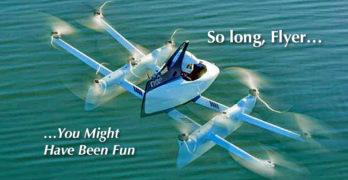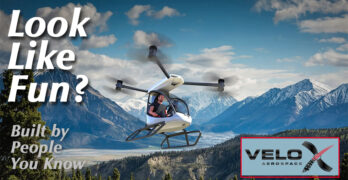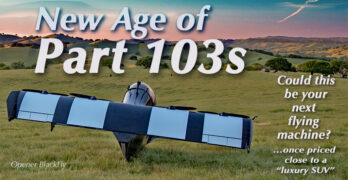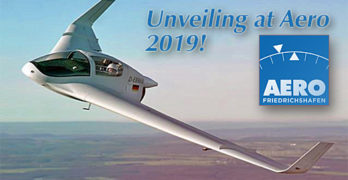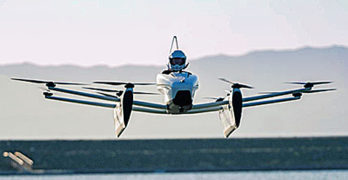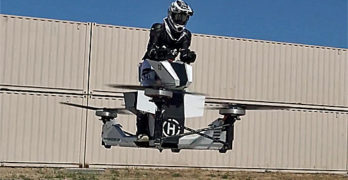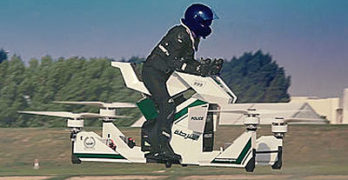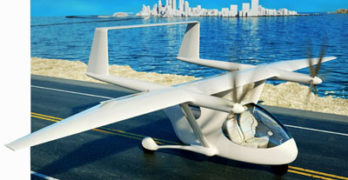As we rush toward the Christmas holiday period and get excited about a new season of flying (after a few more weeks of snow and ice), we have some news to report.
Fortunately, you can stay where it’s warm and just watch — thanks to new videos from DeLand. While I missed my YouTube partner Videoman Dave at the show, I managed to fly solo and shoot video interviews and more on my own. Thank goodness, Dave remains at his video editing equipment and I am pleased to post a couple fresh videos below.
A mere three weeks since Deland Showcase 2019 ended the airshow season for the year, fresh videos are flowing to provide information and entertainment.
DeLand Race Around
We started these quick-tour videos a few years ago and to a certain segment of visitors and viewers, these are hits as they show most of the airplane exhibitors plus give a sense of the event.
Search Results for : kitty hawk flyer
Not finding exactly what you expected? Try our advanced search option.
Select a manufacturer to go straight to all our content about that manufacturer.
Select an aircraft model to go straight to all our content about that model.
Tom Ivicevich’s Wright Flyer
The Wrightness of one man’s dream
On December 17, 2003, Tom Ivicevich’s Wright Flyer won’t represent the only attempt to recreate the brothers’ famous accomplishment. Nor will he be the only Wright pilot flying cross-country to arrive at the sand dune shrine in Kitty Hawk, North Carolina. But Ivicevich will do it all without major sponsorships. And he intends to fly coast to coast in his enhanced version of the original Wright Flyer.
This is one man’s dream, and he is well underway to reaching his goal.
Creating Interest
In January this year, Ivicevich’s 5¼8-scale Flyer flew while being towed by a 1930 Model A pickup truck at Redding Municipal Airport in California. The 190-pound aircraft took readily to the air at 25 mph.
In February, Ivicevich announced, “I am now organizing the start of construction for the full-size Flyer.” Next year, he plans to launch from Torrance, California, and make his way across the country.
A Multicopter Current Pilots Might Enjoy? …Developed Within Our LSA Industry
Here’s a helicopter-like aircraft you might actually consider. I have often reviewed what I call multicopters (several articles). I searched for aircraft you might fly for fun; several of them can enjoy the freedom and special benefits of Part 103. I’ve stayed away from commercial “air taxi” projects.
But what if a longtime producer of Light-Sport Aircraft entered the space? What if the aircraft looked like a helicopter but one you could fly without the steep learning curve? What if it offered 45 minutes of flight with a 15-minute reserve?
The earliest entries had short flight times, 15-20 minutes. Most of them cost too much. For example, Opener’s Blackfly (now called Helix) was first promoted at the cost of a “luxury SUV,” perhaps meaning $80,000 at the time. It has since more than doubled in price.
You may doubt or dislike these flying machines, especially when you don’t know the people behind the projects.
Air Taxi or Air Funster? — 5 Models in Development, as Part 103 Multicopters Not Taxis
If you listen to perpetually-excited media, air taxis will soon be shuttling people hither and yon in all the big cities of the globe. Executives and shoppers will be whisked around downtown skyscrapers silently, quietly, swiftly, and the cost will be modest. Do you buy all that? I’m not holding my breath.
Oh, these air taxi vehicles are coming. I don’t doubt that, if for no other reason than they are absorbing vast amounts of money as people bet on some grand future where infotech merges with aviation to make flying vastly better and easier. It’s a fantastic dream and when smart people powered by enough money work on something long enough… something often happens.
Fine. That’s the sales pitch and apparently it’s working because more than 350 companies around the globe have raised billions of dollars to pursue their dreams yet the first entries remain far from market.
Several people at the very pinnacle of FAA have departed the agency and are now working for air taxi developers (naturally, they are often called by some term other than the mundane “air taxi” label).
Invasion of the Part 103 Multicopters — Surveying 5 Entries, All “No Pilot License Required”
These new-millennia flying machines have inspired multiple names. While an eventual winner is determined, a common handle seems to be the rather awkward “eVTOL” — for electric vertical takeoff and landing. A range of abbreviations are also used: UAV, UAM, UAS, autonomous aircraft, and several others. I like multicopter — because all of them involved multiple propellers doing the lifting.
Most commonly, you hear “drone.”
Yet “drone” is further confusing because we haven’t separated crewed aircraft from uncrewed aircraft and this is a major distinction. FAA has also made this separation, so for this article, I will only speak of crewed aircraft, that is, a flying machine with a pilot using controls to direct its flight. In addition, I will also stick solely to single place aircraft that can theoretically qualify as a legitimate Part 103 ultralight vehicle.
Let me first extend a quick thanks to IEEE’s Spectrum magazine for making me aware of entries I’d missed.
Modern Horten Wing Aircraft Excitement as Aero 2019 Approaches
Something old. Something new. Hang glider pilots I know are very familiar with Horten designs, a form of validation for modern hang gliders …flying wings, aircraft with no tail or fuselage structures. Yet many pilots don’t know Horton and have only a sketchy understand of flying wing stability.
World War II History
As the second great war progressed, Germany sought more advantage as fanatical government leaders pursued their ambitions. The war was dragging on and they needed better war equipment.
In 1943, Reichsmarschall Göring issued a request for design proposals to produce a bomber that was capable of carrying a 1,000 kilogram (2,200 pound) load over 1,000 kilometers (620 miles) at 1,000 kilometers per hour (620 mph) — the so-called “3×1000 project.” Conventional German bombers could reach Allied command centers in Great Britain, but were suffering devastating losses from Allied fighters.
At the time, no aircraft could meet these goals. Junkers turbojet engines could provide the required speed but had excessive fuel consumption.
Hmmm? How Can Duc Hélices Sell More Props? Hey, I Got It! …Multicopters!
Imagine you are in charge of marketing for French propeller manufacturer, Duc Hélices. The boss stops by your office and asks, “How are we going to sell more props?”
You begin to cite statistics (maybe even this website and its market share data). With more worldwide sales of LSA and LSA-like aircraft (chart), sales could be good, you say. Successful twin engine airplanes like Lockwood’s AirCam or Tecnam‘s Twin that swing two propellers per aircraft certainly add to sales. (Rotax enjoys this, too.)
Yet in the tech world, a 10% or 20% increase is nothing. Those hard-charging Silicon Valley companies have gotten used to things improving by orders of magnitude. “How can we increase sales by ten times,” demands the boss?
“Well, hmmm…” you thoughtfully reply, “I think I have an idea.”
Enter Multicopters
The little single place Kitty Hawk Flyer pictured above is one of several examples.
Flying Motorcycle Scorpion Earns “Approval” from FAA
So far, at least three entries* in the multicopter sweepstakes qualify themselves as Part 103 ultralight vehicles. I’m guessing that lead FAA rule writer, Mike Sacrey, never envisioned this idea back in 1982 when he and his team created aviation’s least-regulated aviation sector. In those days, FAA had only recently moved away from requiring that such aircraft demonstrate foot launching.
Mike would have needed a genuine crystal ball to foresee something like Scorpion 36 years ago. Let’s briefly put this in perspective — most readers had yet to buy their first computer; we were still 13 years away from the World Wide Web; it was a quarter century before the iPhone; even Light-Sport Aircraft were 22 years in the future.
Had Mike written a regulation back then to include multicopters like Scorpion he would surely have been relocated to some remote post where his craziness would not be obvious.
April Foolin’? Are You Ready for Hoverbiking on Scorpion 3?
After you finish Easter Sunday dinner with the family, how about going out for a spin on your new Scorpion 3 Hoverbike? Is this merely an April fools joke?
Apparently not. Video appears to prove this machine, though with the state of the art in digital effects, anything you see can be fiction.
As many of us prepare for the start of Sun ‘n Fun 2018 in barely over one week, we hope to see numerous flying machines of interest. My visual partner, Videoman Dave and I will be onsite in Lakeland, Florida — and the following week at Aero Friedrichshafen in the south of Germany. Our mission is to collect a large batch of video that we hope will educate and entertain enthusiasts of light aviation.
I do not expect we will be covering Scorpion 3, but I have to admit I found the idea fascinating.
Will Aviation’s Big Money Create Fun Flying Machines …for the Rest of Us?
Let’s be clear. Boeing, Airbus, Google, Amazon, and other immensely deep pockets are not seeking to build fun flying machines for you and me. Well… not initially, at least. And even that statement is somewhat wrong based on the development of the Kitty Hawk Flyer (video below).
Big money doesn’t begin investing hoping to sell 100-200 aircraft per year. Such a performance would be more than acceptable to most manufacturers of Light-Sport Aircraft, light kit aircraft, or ultralights. Indeed, 200 deliveries a year would qualify as a major success for most such builders.
The billionaire class dreams much bigger, probably thinking they can sell many thousands of aircraft or much higher cost aircraft than we recreational aviators want to buy. Most will center on doing transportation or package delivery. Most will not seek to increase your weekend flying fun.
You know what, though? Neither did the Wright Brothers or the other pioneers of flight have recreation in mind.


